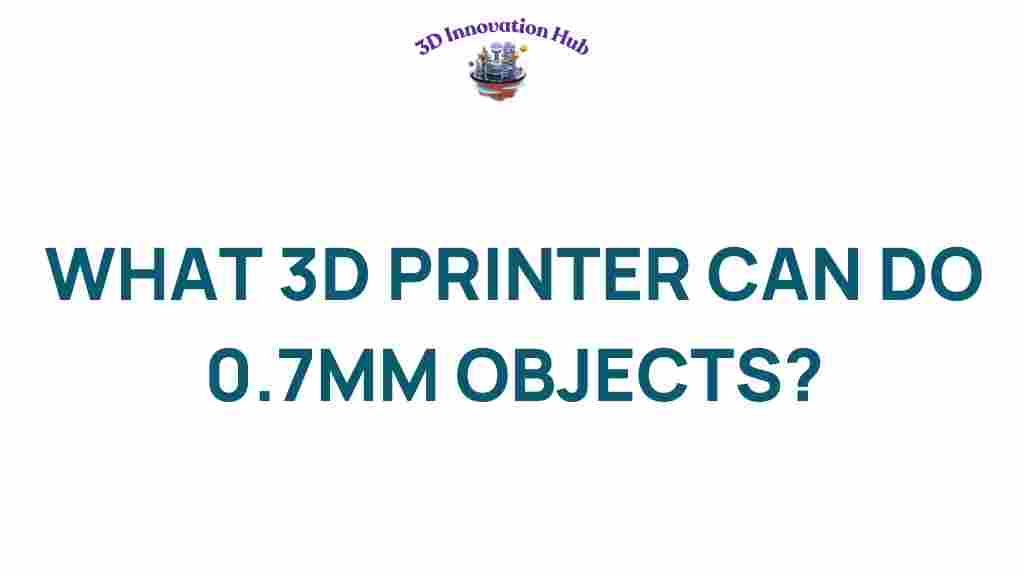Unlocking the Potential: What 3D Printers Can Achieve with 0.7mm Objects
In the realm of 3D printing, the ability to create intricate designs and functional prototypes has revolutionized the landscape of manufacturing and design. As technology advances, the precision of 3D printing has reached new heights, enabling the creation of remarkably small objects, including those as tiny as 0.7mm. This article explores the innovative possibilities that arise when working with such minute dimensions, shedding light on the implications for manufacturing, design, and craftsmanship.
The Basics of 3D Printing Technology
3D printing, also known as additive manufacturing, involves creating objects layer by layer from a digital model. This technology has evolved significantly over the years, allowing for greater precision and versatility in the types of materials used. The process can be broken down into several key steps:
- Design Creation: The first step in 3D printing is creating a 3D model using CAD (Computer-Aided Design) software.
- Slicing: The 3D model is sliced into thin horizontal layers, which the printer will use to build the object.
- Printing: The 3D printer deposits material layer by layer, following the design specifications.
- Post-Processing: Once printing is complete, additional steps like sanding, painting, or assembly may be necessary.
The Importance of Precision in 3D Printing
Precision is critical in 3D printing, especially when creating small objects. A 0.7mm object requires a printer with exceptional resolution and accuracy. The following factors contribute to achieving high precision:
- Printer Resolution: The resolution is determined by the layer height and the nozzle diameter. A smaller nozzle can produce finer details.
- Material Selection: The choice of material affects the print’s quality and precision. Common materials include PLA, ABS, and resin, each with unique properties.
- Calibration: Regular calibration of the printer ensures that dimensions are accurate and consistent.
Innovative Applications of 0.7mm Objects in Various Fields
The ability to print objects as small as 0.7mm opens up a world of possibilities across various industries:
1. Medical Innovations
In the medical field, precision is paramount. 3D printing can create:
- Micro-components: Tiny medical devices, such as stents or implants, can be produced with high precision.
- Custom Prosthetics: Tailored to fit individual patients, providing better comfort and functionality.
- Bioprinting: The possibility of printing cell structures for tissue engineering.
2. Electronics Manufacturing
In electronics, 0.7mm components are essential for:
- Miniaturization: Smaller components lead to lighter and more compact devices.
- Prototyping: Rapid prototyping of circuit boards and enclosures can be achieved efficiently.
3. Artistic Design and Craftsmanship
Artists and designers can utilize 3D printing to create intricate pieces that were previously impossible to manufacture:
- Complex Sculptures: Detailed artwork featuring fine elements.
- Jewelry Design: Customized jewelry pieces with intricate patterns.
Step-by-Step Process to Achieve 0.7mm Printing
To successfully print 0.7mm objects, follow these steps:
Step 1: Select the Right Printer
Choose a 3D printer known for high-resolution capabilities, preferably one that uses resin or has a fine nozzle for filament printing.
Step 2: Design Your Model
Use CAD software to create a detailed 3D model of your object. Ensure that all dimensions are precise and that the design is optimized for printing.
Step 3: Configure Print Settings
Adjust your printer settings to maximize precision. Key settings include:
- Layer Height: Set to a fine resolution (e.g., 0.1mm or lower).
- Nozzle Diameter: Use a smaller diameter nozzle (e.g., 0.2mm).
- Print Speed: Reduce speed to enhance detail.
Step 4: Choose the Right Material
Opt for materials that provide good detail and finish. Options include:
- Resin: Ideal for fine details and smooth finishes.
- PLA: User-friendly and offers decent detail.
Step 5: Print Your Object
Start the printing process and monitor it for any issues. Ensure that the first layer adheres well to the print bed.
Step 6: Post-Processing
Once printing is complete, carefully remove the object and perform any necessary post-processing, such as cleaning, sanding, or painting.
Troubleshooting Common Issues
While 3D printing small objects can be rewarding, it also presents unique challenges. Here are some common issues and their solutions:
Issue 1: Layer Misalignment
Solution: Check printer calibration and ensure that the bed is level before starting the print.
Issue 2: Poor Adhesion
Solution: Ensure that the print bed is clean and properly prepared. Consider using adhesive sprays or glue sticks.
Issue 3: Incomplete Prints
Solution: Monitor for any filament jams or printer malfunctions. Adjust print speed and temperature settings as needed.
Conclusion
The advancements in 3D printing technology have opened up new avenues for innovation and creativity in manufacturing and design. The ability to produce objects as small as 0.7mm not only showcases the precision of modern printers but also highlights the endless possibilities for applications across various industries. From medicine to electronics and artistic creations, the impact of these tiny prints is monumental.
As we continue to explore and push the boundaries of 3D printing, the focus on precision, materials, and technology will be crucial in unlocking even more potential. For those interested in diving deeper into the world of 3D printing, consider exploring additional resources such as 3D printing forums or professional workshops to enhance your skills in design and prototyping.
By embracing the innovations of 3D printing, we can all participate in the future of manufacturing and design, driving forward the craftsmanship that shapes our world.
This article is in the category and created by 3D Innovation Hub Team
